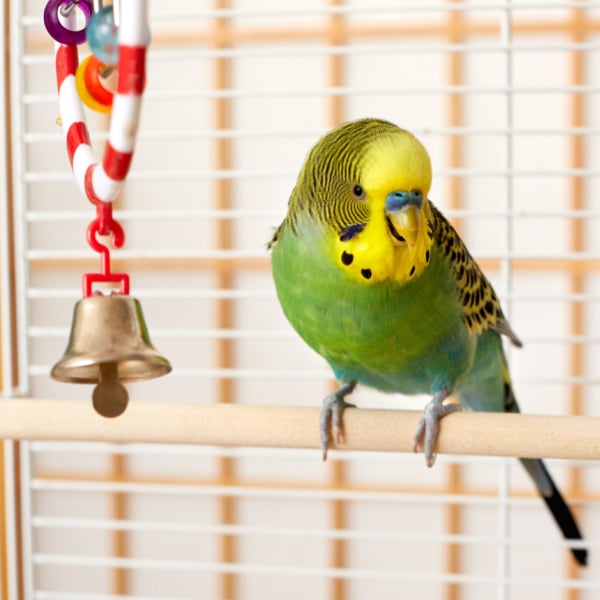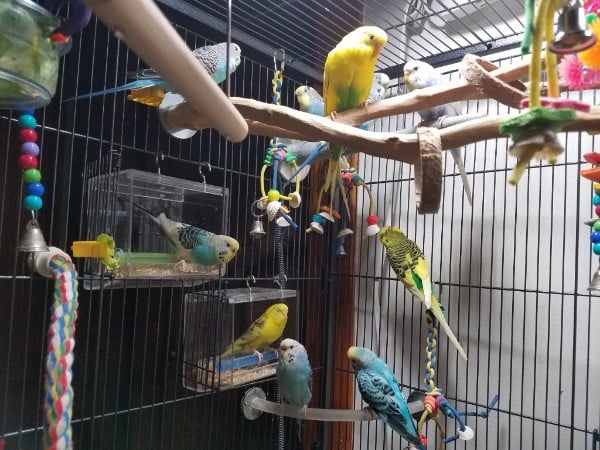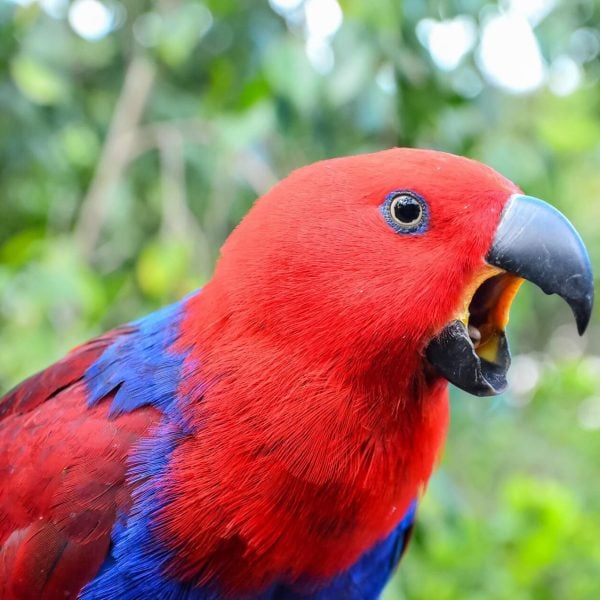
Can I Grab My Parakeets While In Their Cage
Last Updated on by Mitch Rezman
First of all, people who state absolute truths about bird care as in yes and no have much to learn.
To answer this question with an emphatic “no”, begs even more queries:
- It’s time to take the bird to the vet, how do I get it from cage to carrier?
- The bird is sick or injured in the cage, now what?
- How do I get the bird to examine it?
- What if I need to weigh the bird?
If you just want to let the bird out by opening the cage door have you examined your home?
Here’s some of the other answers from Quora
If windows or mirrors are exposed how are you going to prevent your budgie from not flying into a mirror or window and breaking it’s little neck?
This is a video on “bird proofing” our home.
As of November 2018 we now have 10 budgies, all flighted.
They live in a spacious aviary and have more than enough room to fly across the cage and “helicopter” in the middle of the cage.
Every couple of months we take all 9 budgies out one at a time put them into a small travel carrier to weigh them.
Catherine and I take turns – trying not to get bitten – it’s part of captive bird care when you have 10 budgies living in their own “perfect” captive environment.
If you don’t weigh your budgies regularly or any bird for that matter, you may be setting yourself up for failure.
This is because rapid changes in weight is one of the first indications of illness.
Budgies, birds as a rule are renowned for looking healthy one day and then showing up dead on the bottom of the cage the next day.
I would never stick my hand into any birdcage expecting a bird to step up unless I had an established relationship with the animal.
The budgies are quite content to tolerate me and my wife putting our hands in the cage to replace food, water and bathing dishes.
We are content to pull up an easy chair in front of the aviary and watch what I call our “talking flowers”.
It’s quite peaceful.
Interestingly, every once in a while, I will not secure one of the two budgie cage doors and one or two of the hoodlums will escape.
All the windows are covered with plants, flowers and stained-glass discouraging flight into the windows.
Whenever a budgie escapes, it inevitably keeps coming back to the aviary attempting to return into it’s obvious comfort zone.
The New Windy City Parrot Breakfast Club
Bacon – Eggs – Toast – Jam – Biscuit
Gravy – Chicken – Waffles – Bagel – Cream cheese
People think that herding cats is hard but they never tried to grab four escaped budgies in an apartment with 9-1/2 foot ceilings.
Our tool of choice is a handy butterfly net which works quite well.
Once the little parakeets are returned, life will go on in the most extraordinary environment we have provided for them.
It’s also important to know how to hold a small bird once you have captured it.
Protocol dictates that you should keep its little neck between your index finger and middle finger to restrain the bird without getting bitten.
New subject
Our budgie’s cere went from blue to brown, he started ripping out feathers, vet gave him mite shot.
Today he is lethargic.
What could be wrong – (Quora)?
Mites can actually be found both externally and internally in pet birds.
They suck blood from your bird possibly resulting in anemia.
If you think it may be an external problem simply leave a white piece of paper at the bottom of the bird’s cage overnight.
If you wake up in the morning and see mites on the white paper with the naked eye, bring a sample of them to your vet along with the bird.
Internal mites are known as “air sac mites” and must be treated orally or by injection so this vet knew something you didn’t or was acting on the side of caution.
Besides injections, mite defense comes in powders, sprays and oral medications.
Male budgies have blue ceres, female budgies have white, brown or pink ceres, which is the fleshy area at the tops of their beaks.
Mites are EXTREMELY RARE to be found on parrots in captivity.
While aviary birds and birds such as finches and canaries are more susceptible to mites, indoor parrots almost never have issues with mites.
We know this because we get phone calls and emails on a regular basis requesting mite (ant/mosquito/bee/wasp) solutions.
Full transparency, for the past 15 years I have operated one of the largest sites on the Internet specifically for captive bird care.
We’ve learned a lot traveling with our birds to a 300 acre campground on most weekends over those same 15 years.
I write about what I know to be true and accurate.
If it’s anecdotal, I will state that.
Interestingly enough birds like common House Finches in Mexico City will line their nests with used cigarette butts.
Somewhere along the line these finches learned to benefit from nicotine, the same stuff that is a natural insecticide of tobacco plants. Keeping mites and other parasites out of nests.
Dear Cindy
Thank you for contacting us.
The Mite spray you are using is it directed to spray the bird directly? What is the name of the product?
Mites are not that common a problem in caged birds but it is possible.
If wood branches from outside have been used in cages it can occur.
It may help your birds.
We do recommend that you seek out advice from your Avian Vet.
If you need a referral please visit our vet.
Animal House of Chicago
2752 W Lawrence
Chicago IL 60625
773-878-8002
www.animalhouseofchicago.com
Thank you
Catherine Tobsing
<cindy> wrote:
Hello;
My neighbor, Katarina S, has provided your contact information.
A few years ago when she had parakeets that kept having babies, we ended up with one very beautiful one, Blueberry. I think she’s about 4 years old.
I asked her a question and she referred me to you.
We’ve noticed in the last 1-2 months that Blueberry’s cere (I think that’s what it’s called, soft looking spot above her beak that surrounds her nostrils, are very dry and flaky, almost like they are disintegrating.
We had noticed a certain time of the month she’d look different there, but recently it looks quite different than that.
The research we’ve done suggested maybe mites or vitamin deficiency.
So, we bought some vitamin-enriched food since she really seems to only like seed and millet and sometimes honey sticks.
She has not been interested in fruit in the few times we’ve offered it.
We’ve also just recently bought some mite spray from the pet store and mist her twice a week with it.
So far I think we’ve done it 3x in the last 10 days or so.
Is there anything else we might do for her?
Thanks for any suggestions you may have!
We hear the Schulze’s bird, Jake from our house – LOL!
Thanks,
Cindy S.
the Caged Bird Keeping Experts
Dear Cindy
I have looked it up and am not pleased with the ingredients or the instructions.
If you have a mite issue in the cere and they say do not use on the face, what good is it?
I would look for another product, try the VetRX or see your vet.
(Ultracare: Mite and Lice Bird Spray 8 oz. Pump spray.
For control of bird lice on parakeets, canaries, and other caged birds, leave birds in cage.
Remove food and foodstuffs. Spray directly on birds from a distance of 12 to 18 inches.
Avoid the bird’s eyes and face, spray lightly using three or four bursts.
For cage mite control, remove bird(s), food and water cups, etc. and spray cage thoroughly by holding unit at least one foot from surface utilizing five or six bursts.
To control mites and bird lice, may repeat treatment on cage or bird no more than two times a week.
Bird cages should be cleaned in hot water as part of a weekly regimen.)
I wish you the best for your budgies.
Author Profile
Latest entries
 The Traveling BirdJune 26, 2025Can You Name 5 Parrot Species That Are Living Wild in the USA?
The Traveling BirdJune 26, 2025Can You Name 5 Parrot Species That Are Living Wild in the USA? Bird BehaviorJune 26, 2025How is it Parrots Are Problem Solvers Social Animals and Even Use Tools?
Bird BehaviorJune 26, 2025How is it Parrots Are Problem Solvers Social Animals and Even Use Tools? Bird & Parrot AnatomyJune 25, 2025How a Tiny Chemical Modification Makes Parrots Nature’s Living Paintings
Bird & Parrot AnatomyJune 25, 2025How a Tiny Chemical Modification Makes Parrots Nature’s Living Paintings PigeonsJune 20, 2025How Do Parrots Thrive in Cities Outside Their Native Habitats?
PigeonsJune 20, 2025How Do Parrots Thrive in Cities Outside Their Native Habitats?
This Post Has One Comment
Leave a Reply
You must be logged in to post a comment.




Cathy McIvor
2 Dec 2018Your birdies have quite the life – you treat them well.